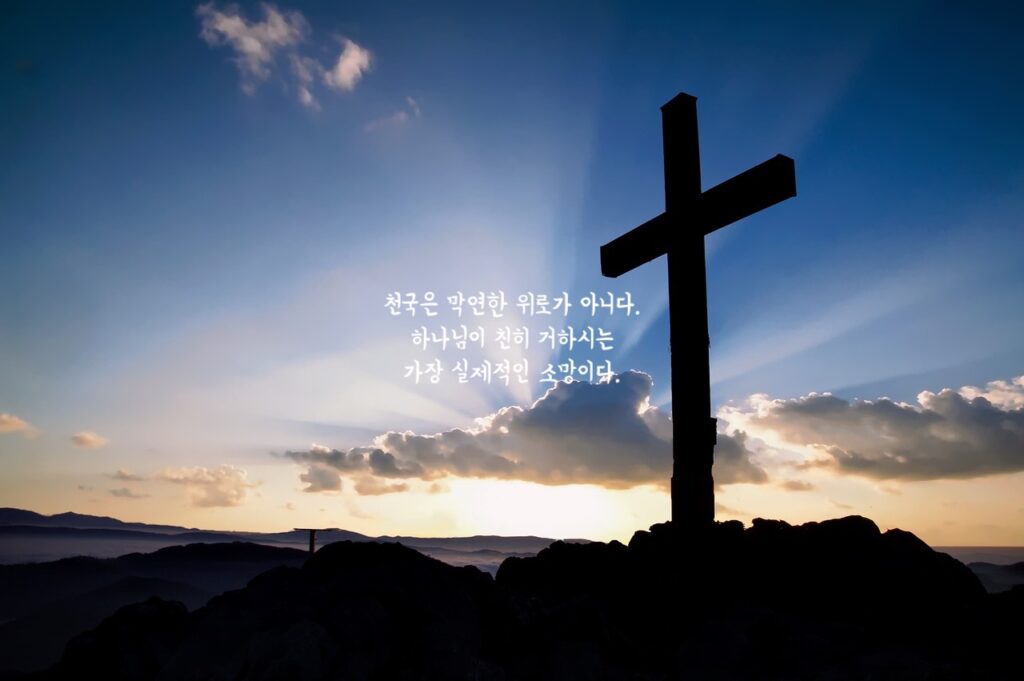The term “end times” often evokes tension and anxiety. However, biblical eschatology is not limited to mere worldly catastrophe or a terrifying day of judgment. Instead, it unfolds within the grand narrative of human history, God’s redemptive plan, and the fulfillment of salvation, aiming more toward restoration and new creation than destruction. The end times represent the final stage where God’s justice is revealed and the door to eternal life is opened. This article explores how the concept of the end times developed throughout the Old and New Testaments and examines its practical impact on Christian faith today.
Old Testament Eschatology – The Hopeful Tradition Awaiting God’s Intervention
In the Old Testament, the end times are more often described as the “Day of the Lord” than the end of the world. Prophetic books like Isaiah, Jeremiah, Ezekiel, and Daniel repeatedly mention this day as both a day of judgment and a day of salvation. It is depicted as the moment when God directly intervenes in history, judging Israel’s sins while also restoring the remnant by His grace.
For example, Isaiah 2 warns, “The day of the Lord of hosts will come upon all the proud and lofty,” yet later envisions a future where “the mountain of the Lord’s house shall be established as the highest of the mountains” and all nations shall stream to it. Thus, Old Testament eschatology focuses less on chronological finality and more on decisive divine intervention revealing God’s sovereignty and justice in history.
Daniel’s Eschatology – The Emergence of Apocalyptic Literature
The book of Daniel offers some of the clearest apocalyptic language and imagery in the Old Testament. Chapters 7–12 employ symbolic visions such as beasts, horns, and heavenly courts to portray the coming of God’s kingdom at the end of days. The declaration that “the kingdom and dominion and the greatness of the kingdoms under the whole heaven shall be given to the people of the Most High” (Daniel 7:27) expresses the certainty that despite worldly empires’ rise, God’s eternal kingdom will prevail. Daniel’s apocalyptic tradition profoundly influenced the New Testament’s Revelation and formed the foundation of Christian eschatology.
This eschatology arose from the desperate hope of the Jewish people suffering under foreign powers like Babylon, Persia, and Greece. The end times were not merely future events but present hope sustaining faith amid hardship. Daniel thus interprets current suffering through the lens of promised divine salvation yet to be fulfilled.
New Testament Eschatology – The ‘Already/Not Yet’ Kingdom
The New Testament reinterprets eschatology centered on Jesus Christ. The Gospels and Epistles teach that God’s kingdom has already begun with Jesus’ coming and will be consummated at His return—the so-called “already/not yet” eschatology. Jesus proclaimed, “The time is fulfilled, and the kingdom of God is at hand; repent and believe in the gospel” (Mark 1:15), announcing the end times as a present reality breaking into history.
Paul, in 1 Corinthians 15, focuses on the resurrection as the pivotal eschatological event: Christ’s rising inaugurates the end times, promising resurrection to believers as well. Thus, eschatology becomes a message of victory, resurrection, and divine triumph rather than fear. Revelation portrays this consummation as the “marriage supper of the Lamb,” heralding the new heaven and new earth’s perfect restoration. The biblical end times are therefore not merely a day of dread but a day of hope for believers.
The Symbolic Language of Eschatology
Eschatology in Scripture often employs rich and symbolic language, culminating in the apocalyptic visions of Revelation. Yet, it is not solely about upheaval, judgment, or disaster. It proclaims the “completion of history” and the restoration of God’s reign. The end times have already begun in Christ and will be completed at His return. Healthy eschatological faith involves not only waiting for the future but living faithfully and holy in the present.
Revelation – Ultimate Hope in Symbols
Revelation offers the Bible’s most extensive depiction of the end times, filled with fearful symbols like plagues, beasts, harlots, dragons, and the number 666. Yet its core message is one of victory. The early church, suffering under Roman persecution, wrestled with whether God truly reigned. Revelation answers with the triumphant Lamb who conquers all powers and promises victory to those who remain faithful.
These symbols should not be taken merely literally. The number seven signifies completeness; the beast represents secular powers opposing God; the harlot symbolizes false religion or corrupt civilization. John uses these images to critique not only Rome of his day but all recurring systems of evil. By interpreting these symbols, believers gain wisdom to long for and discern God’s kingdom amidst worldly systems.
Varied Interpretations of Eschatology
Biblical eschatology, especially Revelation, has been interpreted through various hermeneutical frameworks: Dispensationalism, Historicism, Futurism, Idealism (Symbolism). Dispensationalism reads Revelation as future prophecy with a timeline of rapture, tribulation, Antichrist, millennial kingdom, and final judgment—popular among conservative American evangelicals. Historicism views the prophecies as progressively fulfilled through church history, endorsed by Reformers like Luther and Calvin. Idealism interprets Revelation symbolically as the ongoing cosmic struggle between good and evil. Each approach has strengths and limitations; many modern scholars adopt an integrative perspective.
Misuses of Eschatology – Fear and Political Manipulation
Originally a message of hope, eschatology has sometimes been twisted into tools of fear and conspiracy. Claims such as “Jesus will return at this date” or “666 is encoded in barcodes” cause anxiety rather than genuine repentance or transformation. The 1990s Korean church was shocked by failed date-setting for the end times, illustrating the dangers of such distortions.
When distorted, eschatology may lead to abandoning present responsibilities or escapism, neglecting communal duties and societal restoration. Jesus, however, taught eschatology with calls to “stay awake,” “be faithful servants,” and “live God’s kingdom now.” Healthy eschatology motivates honest, faithful living today rather than merely predicting the world’s end.
The Essence of Eschatology – Viewing the Present through God’s Perspective
Ultimately, eschatology proclaims the “fulfillment of God’s kingdom,” when all evil, pain, tears, and sin will cease and God will dwell with His people in a new heaven and new earth—a hope for believers. Yet this hope requires a life of worship, obedience, justice, and love lived in God’s eternal time every day.
The end times are not the conclusion but a new beginning, affirming that both world history and individual lives are in God’s hands. Thus, eschatology is not merely a future-focused study but a living faith active in the present.
Living Out Eschatology: Faithful Watchfulness and Action
Jesus repeatedly warned of the end but also urged readiness: “Watch therefore” (Matt 24:42) and “Blessed is that servant whom his master finds awake” (Luke 12:37). Eschatology demands active preparation, as illustrated in the parables of the ten virgins, talents, and sheep and goats—wise stewardship, faithful service, and mercy define the waiting believer’s life.
True eschatological faith focuses not on “when will He come” but “what am I doing until He comes,” sometimes called “ethical eschatology.” It’s living out God’s word, not just knowing a timetable.
Teaching Eschatology in the Church – A Needed Restoration
Though long a key preaching theme, eschatology has diminished in modern churches due to fatigue over sensationalist and conspiratorial teachings. Balanced eschatology remains vital. Confessing “Jesus is coming again” inspires worship, ethics, social engagement, and biblical interpretation.
Pastors should teach eschatology connected to ethics, community, spirituality, social justice, and creation care. It’s not merely “the world will end soon” but “how do we steward and serve this earth until that day?” Preaching should restore eschatology as gospel, not instill fear or paralysis.
Eschatology and Social Justice, Environment, and Mission
Far from promoting escapism, eschatology fuels passionate engagement with the world: caring for creation, standing with the oppressed, and spreading the gospel. The promised new heaven and new earth is not just a future realm but a vision to realize now—a kingdom of justice and peace where lion and lamb dwell together. The church is called to embody this kingdom today.
“Maranatha” Faith – Longing for the Lord’s Return
The early church confessed eschatology with “Maranatha” (“Come, Lord!”), a faith marked by hope, not fear; comfort, not dread. Amid persecution, believers found strength and courage in this faith.
Today, the church must recover “Maranatha” faith—a daily awareness of living before the Lord’s return, woven into worship, love, truth, hope, and suffering. “Amen. Come, Lord Jesus” (Rev 22:20) is not a timetable question but a confession of identity.
Eschatology is not mere future speculation but a present attitude longing for God’s reign here and now. Waiting is vigilance, not passivity; confidence is action, not paralysis. Ultimately, biblical eschatology challenges us: “How are you living out the end times today?”
—
Maeil Scripture Journal | Bible Knowledge Plus




